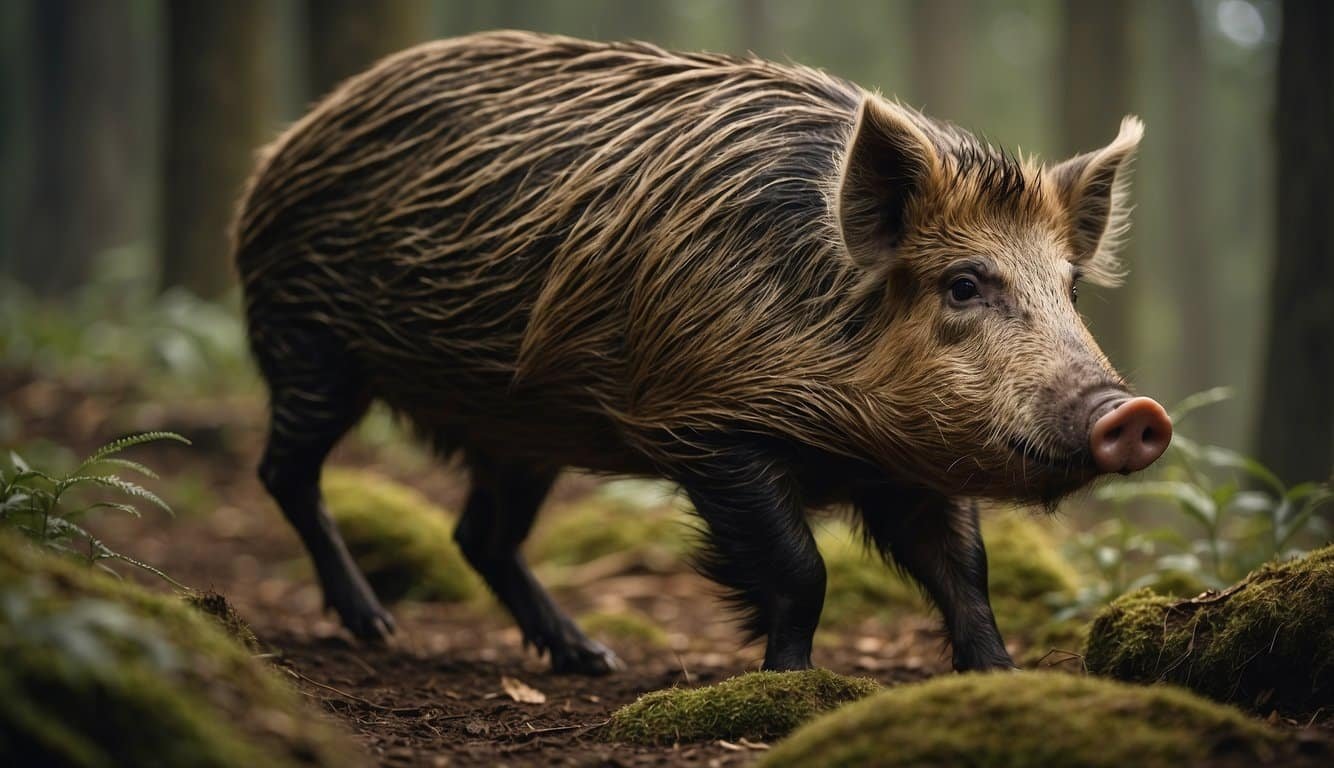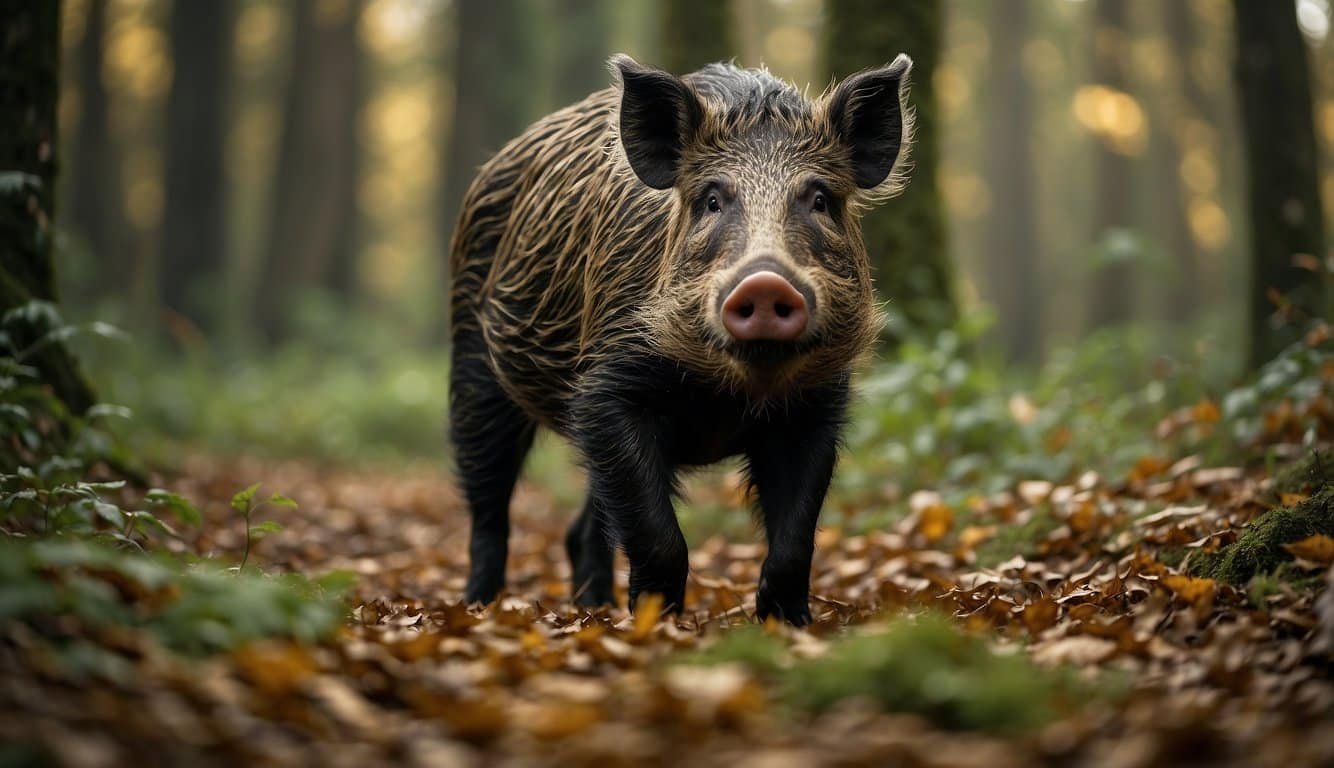Wild Boar Basics
Wild boars, scientifically known as Sus scrofa, are intriguing mammals recognized for their distinct physical features and social behaviors.
This section uncovers their unique characteristics and communal interactions.
Physical Characteristics
Wild boars are robust, stocky mammals.
Adult boars sport coarse, brown hair with longer, stiffer bristles running along their spines.
Their size and weight can vary significantly, but they commonly reach up to 100 kg (220 lbs), with a shoulder height of about 55 to 80 cm (21.7 to 31.5 inches).
One of the boar’s most notable features is their tusks; ever-growing canine teeth that curve upwards used for defense and foraging.
Behavior and Social Structure
Boars are known for their interesting social structure; they form groups called sounders, typically consisting of sows (females) and their piglets.
These groups can range from small families to gatherings of several dozen.
Males, however, are more solitary, especially older ones, and only join sounders during the breeding season.
Boars communicate using a variety of sounds and are known for their intelligence and adaptability, often altering their behavior in response to human activities such as hunting and agriculture.
Habitat and Distribution

Wild boars, or Sus scrofa, are versatile animals belonging to the same family as domestic pigs.
They are known for their ability to adapt to a variety of environments, making them a prevalent species across numerous continents.
Population and Habitat Range
Wild boars are native to vast areas including large parts of Europe, Asia, and North Africa.
A resilient population means they can be found in diverse habitats, ranging from forests and woodlands to grasslands and wetlands.
They are particularly adept at navigating forested regions where they can find shelter and abundant food sources.
The spread of wild boars to regions like India, China, and Indonesia showcases their adaptability, while introductions by humans have expanded their presence to areas like Australia, New Zealand, and the United States.
Unfortunately, this adaptability also contributes to their status as an invasive species in some regions where they disrupt local ecosystems.
Conservation Status
As per the IUCN Red List, the wild boar is categorized as being of “Least Concern” due to its wide distribution and large population.
However, not all is well, as this status does not equate to safety everywhere.
In some areas, their populations are threatened by habitat destruction and extensive hunting, primarily due to their classification as a pest.
While they’re remarkably adaptable, they are still at risk from the usual pressures faced by wildlife, including loss of habitat due to human expansion and conflict with human interests, particularly in the agricultural sector.
Despite these challenges, wild boars continue to thrive in many environments, partly because they have few natural predators once they reach adulthood.
Diet and Lifecycles

Wild boars are eclectic foragers, often described as omnivores due to their varied diet.
Their lives are marked by distinct reproductive patterns that ensure their survival across varied landscapes.
Feeding Habits
Wild boars have an expansive diet that includes roots, nuts, fruits, and crops.
These animals are not picky eaters; they happily consume plants, dig for insects, snatch up eggs, and won’t turn down carrion.
Their feeding habits make them excellent at adapting to different environments.
They are primarily nocturnal, foraging for food under the cover of darkness.
- Primary foods: Roots, fruits, insects, eggs
- Occasional foods: Carrion, crops (such as corn and wheat)
- Feeding behavior: Nocturnal foraging, rooting in the ground with their snouts
Wild boars have an impact on the ecosystems they inhabit, partly due to their food preferences and foraging strategies.
Reproductive Behavior
The reproductive cycle of wild boars is characterized by a gestation period of about 115 days.
Females, known as sows, typically give birth to a litter of piglets once a year, often in a well-concealed nest in dense vegetation.
The reproduction season can vary, but it most commonly occurs in the late winter or early spring.
- Gestation period: Approximately 115 days
- Litter size: Varies, with sows typically giving birth to 4-6 piglets
- Nesting: Sows build nests in dense vegetation to protect piglets
Mating behaviors can be competitive, with males, or hogs, often fighting for the opportunity to mate with receptive females.
Learn more about the intriguing reproductive habits of wild boars.
The diet and life cycles of wild boars reflect their adaptability and resilience, two traits that contribute to their success in the wild and their spread across various continents.

